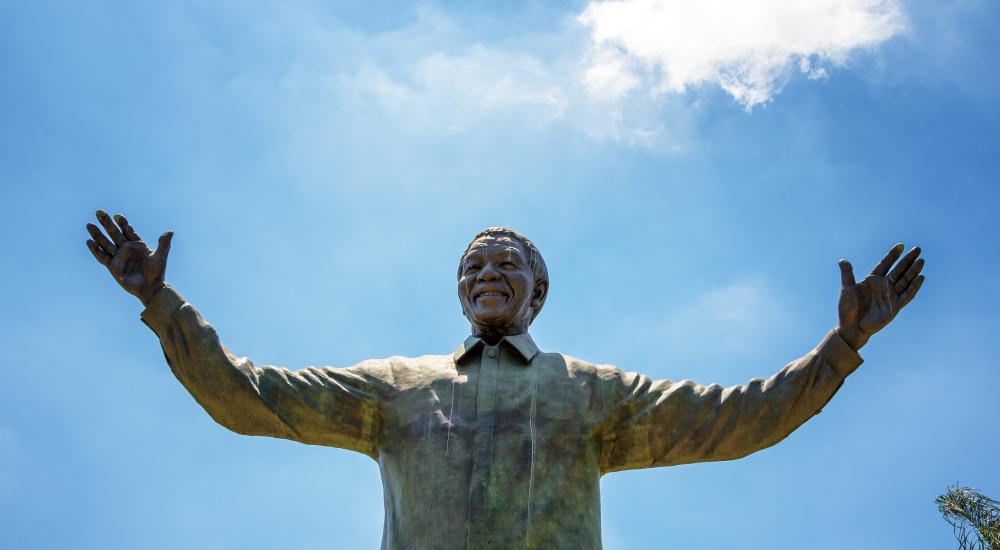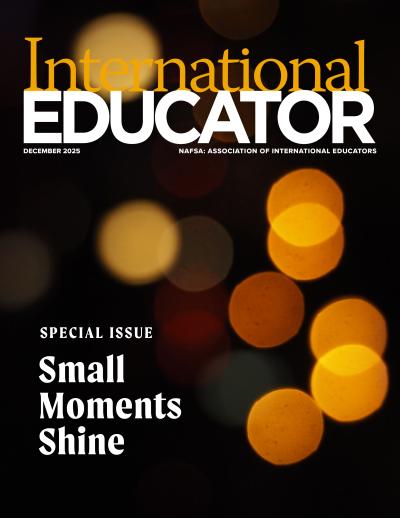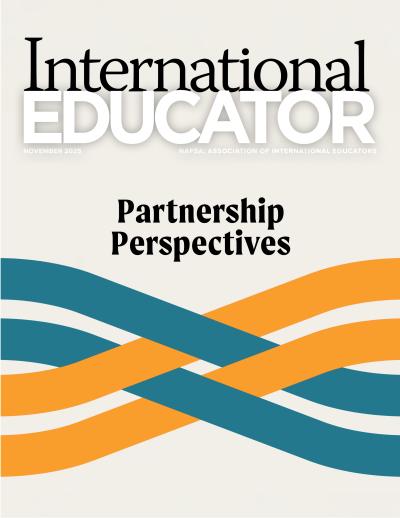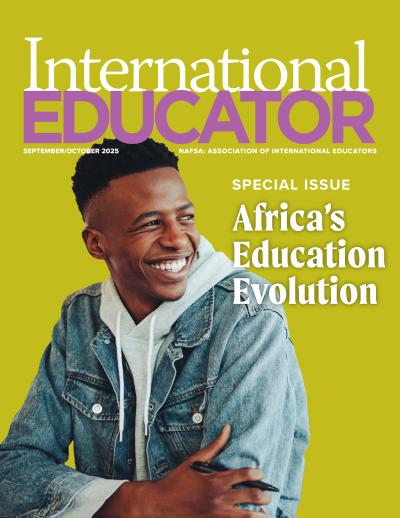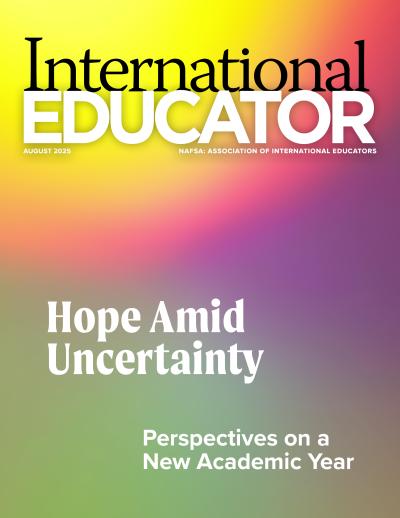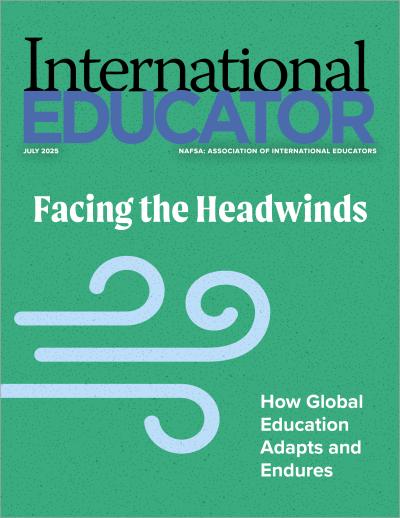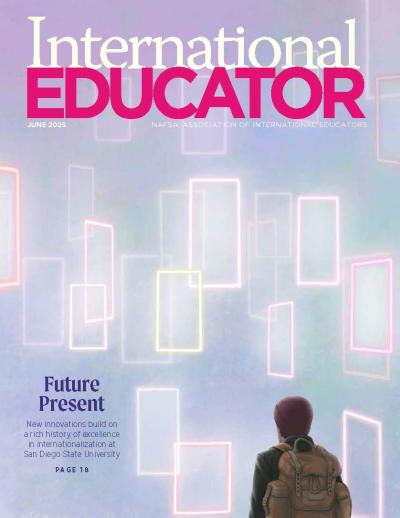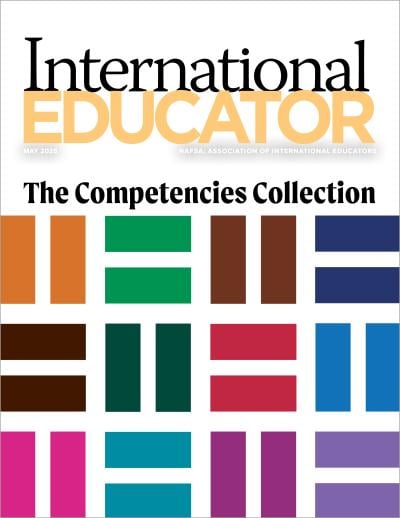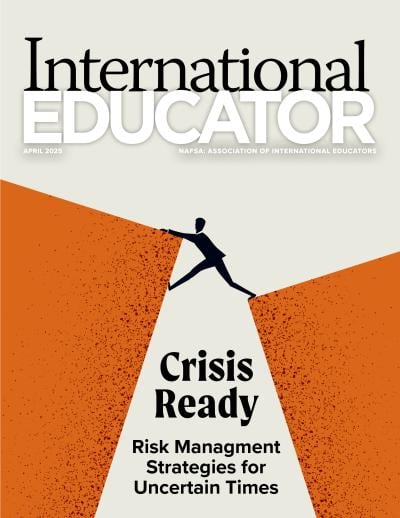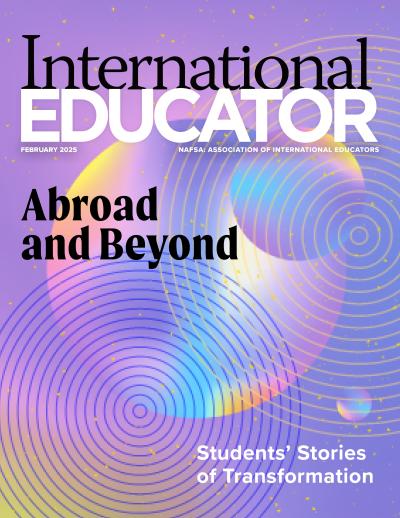Local Roots, Global Impact: An Afrocentric Vision for Higher Education
When Stephen Appiah-Padi was an undergraduate student in Ghana decades ago, he didn't have access to a computer. Today, African students from 42 countries are learning to code on their phones with the help of an artificial intelligence-powered mentor named Kwame developed by fellow Ghanaians. This shift is more than just about advances in technology and education; it is about how they are used within a uniquely African context.
"One of the purposes of technology is [to] benefit society, which is what makes it relevant to the culture," says Appiah-Padi, now director of Bucknell University's Office of Global and Off-Campus Education and a member of the NAFSA Board of Directors. "It is about transforming education to recenter African values, histories, cultures, and knowledge systems."
As education systems across sub-Saharan Africa evolve to address the needs of the continent and its people, an Afrocentric model is emerging—one that moves beyond viewing higher education through a deficit lens or framing the continent primarily as a source market for international students, a site for development interventions, or a soft power opportunity for external actors.
Instead, this vision for African higher education is centered around "strengthening the African identity while tackling continental challenges," says Rose A. Dodd, executive director of the Education Collaborative at Ashesi University in Ghana.
"It drives how we envision the future of our graduates," Dodd adds. "We want to develop entrepreneurial graduates that lead ethically, drive innovation, and are focused on the social well-being of their communities while also being competitive in the global market."
Bridging Past and Future
It can be argued that the university was born in Africa—the University of Al-Karaouine, founded in Morocco in 859 C.E., is the world's oldest continually operating institution of higher learning, according to UNESCO and Guinness World Records.
However, most African institutions were founded in the 1800s and 1900s and reflected the western values and histories of their colonial founders, who brought a fragmented approach to education to the continent.
The legacy of the colonial approach to the university system persists to this day, complicating cross-country exchanges in higher education, according to Godlove Fonjweng, senior international officer at Prairie View A&M University. "There's still a lot of friction," he says.
These colonial vestiges contrast with the dynamism of what is now the world's youngest continent. Some 75 percent of all Africans are under the age of 35, according to UNESCO, which says that higher education in African countries "is at an important turning point, shaped by the continent's dynamic youth population and pressing development challenges. . . . As global challenges increasingly require local solutions, Africa's universities and technical institutions have a critical role to play."
We want to develop entrepreneurial graduates that lead ethically, drive innovation, and are focused on the social well-being of their communities while also being competitive in the global market. —Rose A. Dodd
Given Africa's young population, it's not surprising that enrollment in higher education more than doubled between 2000 and 2021, according to UNESCO. Even so, fewer than 10 percent of sub-Saharan Africans go to college or university, compared to the global average of 38 percent.
At the same time, more than 40 percent of African young adults entering the job market lack the skills needed for employment, exacerbating high unemployment rates. According to UNESCO, 31 percent of the youth population is unemployed or underemployed. The key barrier is a misalignment between higher education systems and labor market demands, according to the NGO.
As a result, colleges and universities across Africa "have been discussing the future of how [to] build resilient, student-focused institutions," Dodd says.
The Vision
In her role with the Education Collaborative, which brings together nearly 50 member institutions representing 350,000 students, Dodd sees the emerging Afrocentric vision of higher education—focused on community and collaboration—mirrored in how many African institutions are starting to see themselves.
"The traditional western global approach to higher ed [focuses on] how one single institution stands out as the model," she says. "On the Afrocentric side, it's more about being a key part of community development, community building, and driving development."
This vision has wide-ranging implications for how institutions are evolving across the continent, including:
Content. Refocusing learning around African philosophy, history, and contexts highlights the stark absence of the African perspective in past years. In his native Cameroon, for example, Fonjweng studied European history and leaders in secondary school. "We learned about the French Revolution. . . . We didn't learn a lot about our own history," he says.
Appiah-Padi points to the Ghanian concept of sankofa, which emphasizes learning from the past to inform a better future. Efforts to decolonize curricula have varied by country, but refocusing learning on the African perspective is an emphasis across all contexts.
"It's about how any institution, whether it's in the West, the East, or the Global South, owns how they show [themselves] to the rest of the world," Dodd relays.
For now, this shift is playing out in various ways in different countries and contexts. The University of Cape Town (UCT) in South Africa, for example, is focusing on centering African artists and history while emphasizing "language justice"—a direct challenge of colonial practices.
"Our assessment systems are largely in English. But what happens when you speak to children in their own languages? They become confident. They want to tell their stories," Msakha Mona, a researcher, artist, and educator at UCT's Centre for Higher Education Development (CHED), said in an interview.
The traditional western global approach to higher ed [focuses on] how one single institution stands out as the model. On the Afrocentric side, it's more about being a key part of community development, community building, and driving development. —Rose A. Dodd
Pedagogy. Institutions are shifting away from centuries-old models to focus on "cocreation," Appiah-Padi says. "It's more about sharing, storytelling, and giving credence to individuals' experiences versus 'here is the text,'" he says.
That also implies a shift toward "centering the student in the work of our institutions," adds Dodd, highlighting the focus of the Education Collaborative's most recent convening in June.
African institutions, Dodd says, have focused on preparing students "to contribute to their country and continental development and growth. Now, we are recentering the student in how we are working towards what we had in our sights."
Purpose. Dodd and others describe the Afrocentric vision of learning as focused on individual development and career preparation in service of a broader impact on the community. This impact is accomplished by preparing students to lead African development, societal change, and key national and continental initiatives. Appiah-Padi points to the South African concept of ubuntu, which means "I am because we are" or "humanity towards others."
"The connectedness of humanity informs the communality of the things we do, including education," he says.
Structure. Familiar collegiate structures and traditions are being rethought and reworked to emphasize an Afrocentric perspective. "There's going to be a transformation of the entire education system," Appiah-Padi says.
"The challenge is sitting down and critically analyzing what is happening in our institutions. Because of the colonial legacies, challenging these structures means you are now rewriting the whole system of higher education [by] critically confronting established systems that are already there," he continues.
Two examples illustrate how thorny change within the confines of historical contexts can be. According to Appiah-Padi, many African institutions now have African studies departments focused on centering the continent's history and perspectives, but some educators have raised concerns that these standalone departments could undermine broader systematic changes.
In similar fashion, some African institutions actively compete for a place in global ranking lists, in part to win funding and facilitate more productive partnerships with the Western world, according to Appiah-Padi. "But an Afrocentric vision is not about doing something well in the world but doing something well within the society that you are in," he says. "If there are no changes in the [local] environment, society, or the country, you have to ask 'whose interests are we serving?'"
Orientation. Importantly, an Afrocentric vision of higher education transcends the continent's boundaries. Despite their focus on the local context, African institutions aspire to produce graduates competitive with global peers.
This vision also extends to the Diaspora regions touched by slavery, including the United States, the Caribbean, and South America. That's why the HBCU Africa Education Coalition's (HAEC) 100,000 Strong Africa Initiative supports study abroad opportunities for students of African descent, particularly to Africa and its Diaspora regions.
"We believe it's really important, particularly for students of African descent, to go to the continent or the Diaspora first because it will ground them in their ancestral identity and give them a structure and a base to go to other places in the world," says Mark Brinkley, HAEC's chief financial officer. "It aligns with the mission of producing global leaders."
New Models for the World
As it emerges, the Afrocentric approach is both complementing and providing new models for higher education. Among them:
Community-centered education models. African four-year institutions are increasingly focused on "designing new programs to fit [local] emerging jobs to keep African students in their countries," Brinkley says.
Along with promoting service learning, community engagement, and soft skills development, institutional leaders are drawing from the United Nations Sustainable Development Goals and Agenda 2063, the African Union's framework of seven aspirational goals, as roadmaps for ensuring what they teach meets the needs of their communities and continent.
"The structures are there," Appiah-Padi says. "The change might be slow, but we're moving in the right direction."
Because of the colonial legacies, challenging these structures means you are now rewriting the whole system of higher education [by] critically confronting established systems that are already there. —Stephen Appiah-Padi
Sustainable leadership. African higher education is increasingly focused on developing programs that are focused on key challenges, including climate resilience, renewable energy, and sustainable agriculture, in recognition of the fact that "students in the classroom will be future leaders in government," Brinkley explains. "Universities are fostering self-reliance by equipping students to create sustainable economic opportunities and drive development."
For example, the Afrocentric vision offers an alternative approach to artificial intelligence (AI), one that reflects the technology's potential for the continent, according to Brinkley.
"In Africa and [throughout] the Diaspora, they think AI can level the playing field," he says. "[These regions] have a population that's ready to be employed, and they are looking at it from a creativity-enhancing and capacity-building model."
The opportunities—and challenges—related to AI are also informing collaborative approaches within and beyond the continent. Noting that Ashesi University was the first on the continent to adopt an honor code, Dodd says that the Education Collaborative is promulgating similar models at other institutions in response to the AI boom creating "a sudden need for ethics to be at the center of higher ed, [and] not on the peripheries," she asserts.
HAEC is also collaborating on community-focused AI competencies across HBCUs and in partnership with African institutions, including the pan-African African University of Communications and Business (AUCB), which itself engages with universities in more than 55 countries.
"We're at a point where AI is so important that not being competent in [its use] will affect our leaders for generations," Brinkley says. "That window is only open for a short time."
Cross-border collaboration. There's growing interest in a collaborative, pan-African model of approaching curriculum, pedagogy, and research. To this end, a growing number of collaborative organizations, many founded in the past decade, are advancing this aspiration.
Appiah-Padi points to more than 80 centers of excellence in higher education—initiatives driving institutional change across at least 20 African nations. With an emphasis on developing "authentic African knowledge systems," these centers are focused on "solutions for Africa and solutions from Africa," he says.
In similar fashion, the African Research Universities Alliance (ARUA) is a collaborative network of 16 research universities in Africa. The organization was founded in 2015 to "develop local research excellence through collaboration to find solutions to the development problems of Africa," according to ARUA's website.
The Education Collaborative represents another model for collaboration. Started at Ashesi University in 2017, the Collaborative addresses a wide range of higher education issues, including employability, systems development, ethical leadership and culture, faculty research, and development "in ways that are relevant to our societies and communities," Dodd says.
Using regional hubs across the continent to ensure concepts meet local contexts, participating institutions share best practices on topics including peer learning, mentoring, and career services.
Beyond the continent, the HAEC "serves as a catalyst between HBCUs and African higher education institutions," according to Brinkley, by promoting study abroad, faculty research and exchange programs, and a 2+2 model where students complete their studies across African institutions and HBCUs.
We believe it's really important, particularly for students of African descent, to go to the continent or the Diaspora first because it will ground them in their ancestral identity and give them a structure and a base to go to other places in the world. It aligns with the mission of producing global leaders. —Mark Brinkley
For example, the Historic African Diaspora Placement Program, operated in partnership with the Association of African Universities, the Africa Capacity Building Foundation, and the UNCF Institute for Capacity Building, places HBCU graduates and faculty in African universities to facilitate knowledge exchange, cultural immersion, and capacity building—and to promote pan-African solidarity.
A focus on student mobility. Even as immigration regulations and political climates have complicated cross-continental exchange, African institutions are addressing structural challenges and pushing back against the longstanding tendency to send students to Western countries instead of other countries in Africa.
"Many major universities now have diversity, but most still do not," Fonjweng says. "Bringing students from other countries introduces new dimensions of thinking."
These efforts date back more than a decade; in 2014, the Addis Convention was ratified, aiming to improve interuniversity cooperation and mobility across national boundaries by creating a legal framework to recognize and evaluate academic qualifications. To date, 14 countries have signed on to the convention, which went into force in 2019.
"It seems simple, but it isn't," Dodd says. "A student from Kenya moving to Ghana might have to [take] five years instead of four [to complete their degree]. But we're beginning to crack that code."
Virtual collaborations and digital education platforms such as the African Virtual & e-University also provide opportunities to expand access to quality education across geographic and socioeconomic boundaries, according to Brinkley.
Going Global
The African higher education sector is drawing upon many strengths as it continues to reinvent itself. Its historic emphasis on rigor and the continent's growing youth population have contributed to highly selective institutions that produce graduates who are prepared for further study, according to Fonjweng.
Graduates from an Afrocentric university will come out knowing and following their own histories, traditions, and ways of knowing things. Once we have an African identity steeped in African education, we'll be on the way towards true global leadership development. —Stephen Appiah-Padi
Historical resource constraints have also promoted a culture of innovation, one which extends well beyond academia. Dodd points to the rapid—and early—adoption of mobile payment systems across the continent as an example of how ideas can scale across multiple countries and contexts.
"We have been able to pilot and prototype models that can be refined and used by millions," she says. For example, one career services model initially developed at an institution with 1,200 students was systematically replicated and scaled at a 40,000-student university.
Through similar efforts, African higher education will ultimately use "Afrocentrism to connect to the globe," Appiah-Padi asserts.
"Global citizenship gives us the ability to connect [with] other humans around the world. [But] before someone can connect [with others], they have to know [themselves]," he says.
"Graduates from an Afrocentric university will come out knowing and following their own histories, traditions, and ways of knowing things. Once we have an African identity steeped in African education, we'll be on the way towards true global leadership development." •
About International Educator
International Educator is NAFSA’s flagship publication and has been published continually since 1990. As a record of the association and the field of international education, IE includes articles on a variety of topics, trends, and issues facing NAFSA members and their work.
From in-depth features to interviews with thought leaders and columns tailored to NAFSA’s knowledge communities, IE provides must-read context and analysis to those working around the globe to advance international education and exchange.
About NAFSA
NAFSA: Association of International Educators is the world's largest nonprofit association dedicated to international education and exchange. NAFSA serves the needs of more than 10,000 members and international educators worldwide at more than 3,500 institutions, in over 150 countries.
NAFSA membership provides you with unmatched access to best-in-class programs, critical updates, and resources to professionalize your practice. Members gain unrivaled opportunities to partner with experienced international education leaders.


